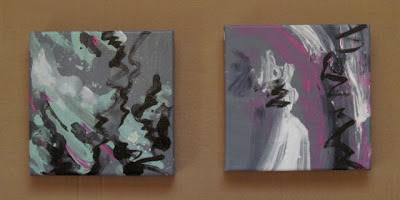I was happy to be able to see several exhibitions, attend an opening and visit another grad student last weekend in Halifax while also meeting with my mentor, Suzanne Gauthier.
I returned to see "Canadian Pioneers: Tom Thomson, Emily Carr, J.W. Morrice and the Group of Seven, Masterworks from the Sobey Collections." The works in this exhibition are on public display for the first time. The list of prominent Canadian artists is much longer than the title of the show implies. The painting that impressed me the most is a large oil study of a grey rock outcrop, with several brilliant red maple saplings in front of it and mist blue hills barely visible in the background. Almost the entire composition is in shadow, with subtle gradations and variations of grey modelling the rock face in large brushstrokes. The color relationships are outstanding, The red is brilliant, but judiciously used against the nuances of the stone. I sat in front of this work for at least twenty minutes absorbing it as there are no reproductions of it available.
There were other fantastic paintings as well. High Water by A. J. Casson is very memorable also. I always enjoy seeing work by Emily Carr. I think I have adopted some of the greens she used in her paintings of the forests of British Columbia.
After Suzanne and I discussed my current work, we headed downtown to NSCAD to visit another grad student in his studio. Conor Fagan was working on a new canvas and a small study in preparation. He uses man-made and organic small objects under spotlights and creates whimsical scenes where ceramic boiled egg-holders become floating ducks or laughing monks. It was interesting to talk to him about his work and then show him my blog.
The gallery, Studio 21, has moved to a new and much larger location. The opening on Friday night was very well-attended, even crowded and I ran into two friends from my undergrad years whom I hadn't seen for a very long time. One was Susan Wood, one of the featured artists in the new Studio 21 exhibition. Her drawings are sensitive, beautiful and restrained. Susan has developed her own way of using collage under her drawings, which seems to convey a sense of timelessness and nostalgia.
Another show I was fortunate to see is "Synchronicity" at the Secord Gallery. I particularly responded to Leya Evelyn's abstract paintings. Suzanne had recommended that I look at her work online, which I had done during the summer. It is never the same, however, as seeing the actual artwork. Leya creates textures on her canvases with what seem to be sand and fibrous materials as well as rectangles of canvas. Over this surface, she adds small accents of collaged patterned fabric and paper and rich, textural colors in oil paint.
I wanted to rush home and take out my oil paints right away. Never mind the odor or the slow drying time! I will put up with it. I haven't been able to duplicate the subtlety of oils using acrylic paints. Hopefully I will be able to work in oils without aggravating my asthma.
Sculpture by Brad Hall was also interesting. Brad combines several elements together with ease, such as wood, copper, steel, and aluminum, utilizing their individual textures.
View the show online at:
On the way back home, I stopped at a metal recycling establishment, otherwise known as a junkyard! My next painting may have bits of discarded machinery amongst the lush undergrowth of my imaginary back yard. Suzanne sent me there and along with directions from the gas station attendant and my GPS, I arrived at the right place. The yard is open on weekdays only, so I took a few photos. Maybe next time I am passing by, I will stop in and pick up some rusty treasures for my studio. I find having a few concrete objects in front of me while I am painting to be extremely useful. There are also the junkyards of Moncton to explore, a little closer to home.
 |
| Jones & Son Metal, Truro, NS |
This place has a huge metal crusher. I was kind of glad it wasn't in operation while I was there! It does create some interesting folds and permutations in the metal, however.
 |
| Harmony Acrylic on Canvas 8" x 10" |
I stained the canvas with acrylic inks, and then interrupted the strokes with black paint. I like the contrast between the watery pigments and the thick paint.
 |
| Aqua Dream and Pink Flow Acrylic on Canvas 8" x 8" |
Here I was trying out several ways of applying opaque acrylics over a medium grey. I probably need to work on these more. Perhaps I will experiment with oil glazes over the acrylic.
Today I began working on my 72" x 40" canvas, applying modelling paste in some areas and texturing its surface by patting it with a large palette knife. I am planning to sand down the spiny points a bit before washing pools of paint over the canvas.















































